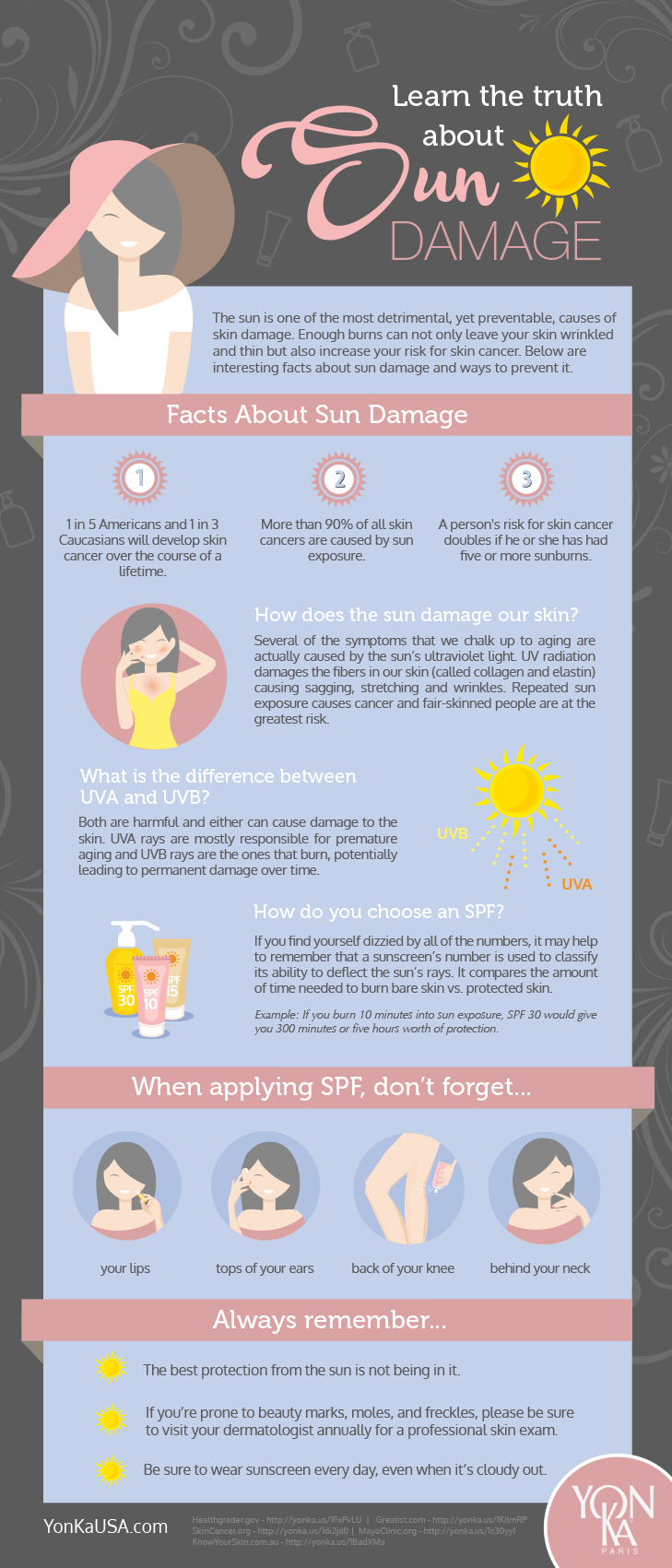May is the gateway to summer and it’s also recognized as Melanoma/Skin Cancer Detection and Prevention month – just in time for the sunniest season. Since the days of May are dedicated to raising awareness around the most common type of cancer in the U.S. (of which Melanoma is the most dangerous), I took it upon myself to study up on the truth about sun damage.

A few quick facts…
- 1 in 5 Americans and 1 in 3 Caucasians will develop skin cancer over the course of a lifetime. (source)
- More than 90% of all skin cancers are caused by sun exposure. (source)
- A person’s risk for skin cancer doubles if he or she has had five or more sunburns. (source)
How exactly can the sun damage our skin?
Cancer aside, several of the symptoms that we chalk up to aging are actually caused by the sun’s ultraviolet light. UV radiation damages the fibers in our skin (called collagen and elastin) causing sagging, stretching and wrinkles. Repeated sun exposure causes cancer and fair-skinned people, like myself, are at the greatest risk.
What is the difference between UVA and UVB?
Unless you’re into measuring wavelengths (UVA rays are longer, UVB are shorter) – the only important thing to know is that both types of the sun’s rays penetrate the atmosphere and contribute to cosmetic skin damage and cancer. Both are harmful and either can cause damage to the skin. UVA rays are mostly responsible for premature aging and UVB rays are the ones that burn, potentially leading to permanent damage over time.
How can you protect yourself from sun damage?
There is no way around it: SPF is your only option, but in the land of SPF itself, there are a lot of options. If you find yourself dizzied by all of the numbers, it may help to remember that a sunscreen’s number is used to classify its ability to deflect the sun’s rays. It compares the amount of time needed to burn bare skin vs. protected skin. As an easy example, I would probably burn about 10 minutes into sun exposure, so SPF 30 gives me 300 minutes or five hours worth of protection.
When shopping for SPF, reach for a minimum of SPF 15 and choose something waterproof, if at all possible. Follow the “shot glass rule” and make sure to apply SPF liberally to all exposed skin. (A good trick is to put it on in the nude before you slip on your suit. That way if your straps move around, you’re less likely to get crazy tan lines.)
Which SPF is best?
These days, sun protection comes in all shapes and forms. Classic SPF is designed to absorb and dissipate the sun’s rays while newer mineral options work to scatter and reflect UVA/UVB. Just remember to apply a classic SPF 20 – 50 minutes before sun exposure.
Don’t forget…
- Your lips
- The tops of your ears
- The backs of your knees
Excuses, excuses.
The best protection from sun is not being in it. No one will think you’re weak or wimpy for seeking shade. You’re preventing cancer for goodness sake! And while you may think that getting a healthy dose of Vitamin D is a great excuse to sunbathe, it’s much safer and easier to work this nutrient in through diet or even supplements.
The best prevention is early detection.
If you’re prone to beauty marks, moles, and freckles, please be sure to visit your dermatologist annually for a professional skin exam. As someone who has had the occasional questionable spot removed, I feel compelled to remind you that you’re better safe than sorry.
It is important to know these facts and the truth about sun damage so that we can take proper measures to prevent skin cancer. Thanks for sharing!